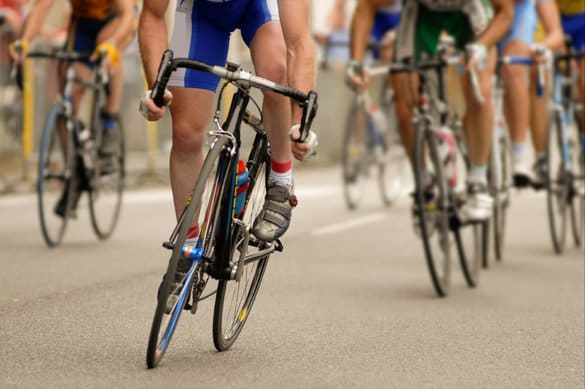Most riders enjoy a sprint once in a while with the group they train with. It can be a perfect simulation of the challenges at the end of a race.
If you organize these random sprints, you have the opportunity to make your sprints a lot better and still have a lot of fun battling with your friends. Here are some sprint sessions which may help you to become a better sprinter:
Sprint Program for Cyclists #1
15 minutes warm-up (increasing intensity)
8 x 10-sec group sprint. 5 min recovery between each sprint.
This program is a simple example of solid principles that you should use in sprint training.
Please note that after each sprint, you should have a long recovery before your next sprint. Having this long recovery will make maximum effort in each sprint and get a great stimulus for every muscle fibre involved in sprinting.
It is a mistake to believe sprint training should only be done after long rides to simulate “the real thing.”
You have probably lost concentration and motivation when tired and dehydrated, and your glycogen stores are empty. The circumstances might be psychologically comparable to race situations, but they will never represent optimum training of your physiological sprinting skills.
Sprint Program for Cyclists #2
15 minutes warm-up (increasing intensity)
5 x 10-sec power sprint. 5 min recovery between each power sprint.
Slow down your bike and then do a maximum acceleration in a high gear (53×14-16). This exercise is probably the closest you can get to specific maximum strength training on your bike.
This workout can easily be performed a couple of times each week because of the minimal recovery needed after these power sprints. However, it should be emphasized that recovery periods between power sprints must be long enough to ensure a full recovery.
It is an excellent idea to analyze your efforts afterwards, like any other workout. However, group sprints are more complex to study because you train several different skills (technical, tactical, and physiological), while power sprints are pure power training.
Again I need to mention that a power meter is a fantastic analysis tool providing objective feedback for your efforts.
Finally, don’t forget to read the real secrets of successful sprinters.


Great workouts, it feels much better when take a longer recovery between my sprints. Normally I try to rush through my sprint sessions (when I remember to do them…)
I note what was said about not doing the sprint efforts at the end of a long ride. I wonder if it would be better to spread them out during a longer (duration of 3 – 4 hrs) ride, or if to do them in the first hour of the ride?
@Michael – The secret behind successful sprint training: Don´t hurry.
@Howard – I would recommend to perform the sprints during the first hour with them same reasons as mentioned in the article. Though, your suggestion with spreading the sprints throughout the training session could be a good compromise.
I’m thinking of increasing my sprinting maximum speed from my 26 mph slowness up to 33 or even 37 mph (top speed on a road bicycle) and want to know what people usually end up achieving religiously following a set program for 1 month, 3 months, and a year. Beyond my measly 3 days of training I would invest another hour per week. I usually either go on a particular day 2 miles running or 15 cycling, but I want to add sprinting to my routine and need a baseline comparrison to a typical beginner sprinter cyclist.
I’d like to know what type of progress people usually have with following a specific training program….? You can choose any good program and answer accordingly.
Would these same basic principles work in a gym on an upright bike machine?
Where one would manually increase the resistance level on the machine with personal intensity during sprint periods?
Thanks.